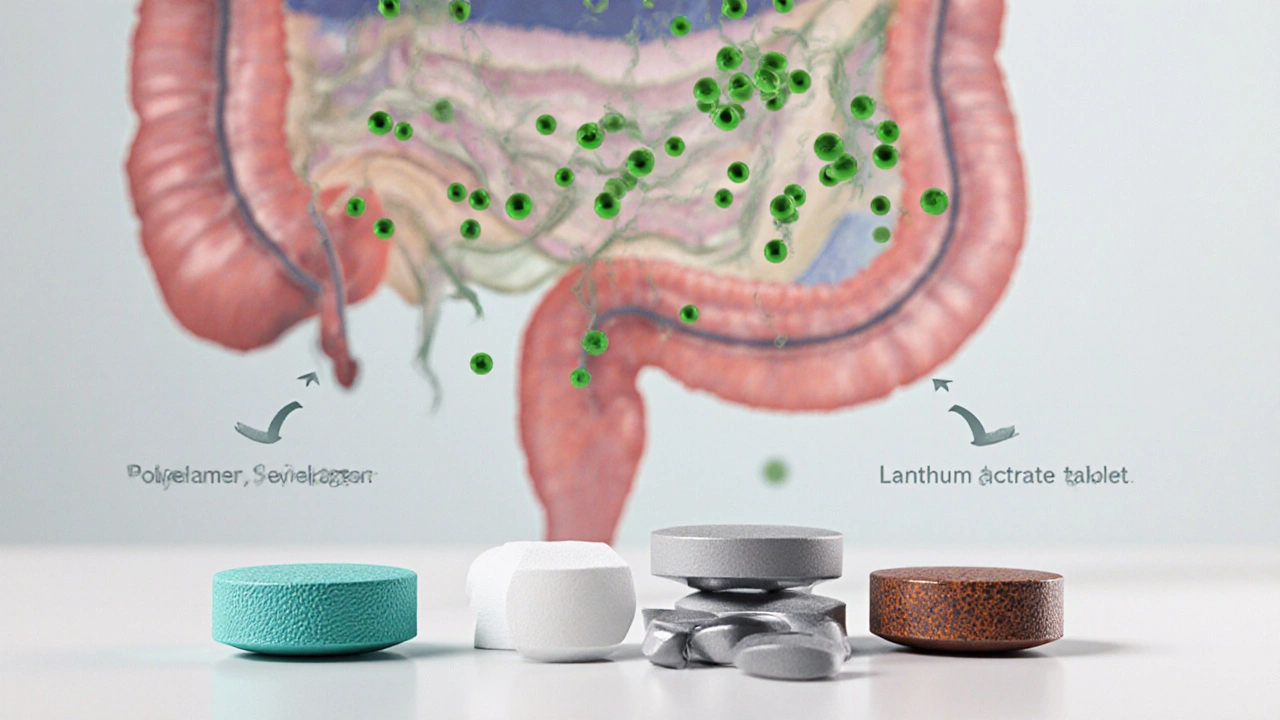Quick Take
- Renagel (Sevelamer) is a non‑calcium, polymer‑based binder that lowers phosphate without raising calcium.
- Calcium acetate is inexpensive but may cause hypercalcemia and vascular calcification.
- Lanthanum carbonate works well for severe hyperphosphatemia but is pricey and can cause GI discomfort.
- Ferric citrate binds phosphate while also treating iron deficiency anemia, offering a dual benefit.
- Choosing the right binder depends on kidney stage, calcium load, cost, and personal side‑effect tolerance.
Why Phosphate Binders Matter in Kidney Disease
When kidneys can’t filter waste, phosphate builds up, leading to bone disorder and heart‑related calcification. This condition, known as hyperphosphatemia an elevated level of phosphate in the blood, commonly seen in patients with chronic kidney disease (CKD), is managed by limiting dietary phosphorus and adding oral phosphate binders.
Patients on dialysis-whether hemodialysis or peritoneal dialysis-are especially vulnerable because their residual kidney function is minimal. The goal is to keep serum phosphate within the target range (usually 2.5-4.5 mg/dL) to protect bones and blood vessels.
What Is Renagel (Sevelamer)?
Renagel Sevelamer a non‑calcium, polymer‑based phosphate binder approved by the FDA in 2005 works by binding dietary phosphate in the gut and preventing its absorption. Because it contains no calcium, it doesn’t add to the calcium load, making it a go‑to option for patients with a history of vascular calcification.
The drug comes in chewable tablets (800mg) and powder for oral suspension. Typical dosing is 800mg with each major meal, adjusted based on serum phosphate levels. Common side effects include constipation, nausea, and a metallic taste.
Alternative #1: Calcium Acetate
Calcium acetate the most widely used calcium‑based phosphate binder, approved in 1990 works by providing calcium that binds phosphate in the gastrointestinal tract.
Advantages:
- Low cost-often the cheapest binder on the market.
- Dual benefit of supplementing calcium, useful for patients with low calcium levels.
Drawbacks:
- Risk of hypercalcemia, especially when combined with vitamin D analogs.
- Potential to accelerate vascular calcification, a major concern in long‑term dialysis patients.
Alternative #2: Lanthanum Carbonate
Lanthanum carbonate a lanthanide‑based phosphate binder introduced in 2006 binds phosphate through a high‑affinity, non‑calcium mechanism similar to Sevelamer but with a different chemical structure.
Pros:
- Effective even at lower pill burden compared with calcium‑based binders.
- Minimal impact on serum calcium levels.
Cons:
- Higher out‑of‑pocket cost; insurance coverage varies.
- Occasional gastrointestinal complaints such as nausea or constipation.

Alternative #3: Ferric Citrate
Ferric citrate an iron‑based phosphate binder approved in 2015, also indicated for treating iron deficiency anemia in CKD captures phosphate while delivering iron that can improve anemia.
Key strengths:
- Dual therapeutic effect-phosphate control plus iron repletion.
- Lower calcium load, similar to Sevelamer.
Potential issues:
- May cause dark stools, which can alarm patients.
- Risk of iron overload if not monitored properly.
Head‑to‑Head Comparison
| Attribute | Renagel (Sevelamer) | Calcium Acetate | Lanthanum Carbonate | Ferric Citrate |
|---|---|---|---|---|
| Mechanism | Non‑calcium polymer binder | Calcium‑based binder | Lanthanide‑based binder | Iron‑based binder |
| Typical Daily Dose | 800mg per main meal (≈2.4g) | 667mg per meal (≈2g) | 750mg per meal (≈2.2g) | 1g per meal (≈3g) |
| Cost (US, 2025) | ~$120/month | ~$30/month | ~$150/month | ~$110/month |
| Impact on Calcium | No increase | Raises serum calcium | Neutral | Neutral |
| Common Side Effects | Constipation, metallic taste | Hypercalcemia, constipation | Nausea, constipation | Dark stools, GI upset |
| FDA Approval Year | 2005 | 1990 | 2006 | 2015 |
How to Choose the Right Binder for You
Pick a binder based on three practical lenses: calcium load, cost, and side‑effect profile. If you have a history of vascular calcification, non‑calcium options like Renagel or Ferric Citrate are safer. When budget is tight, calcium acetate often wins the price battle but requires vigilant monitoring of calcium levels.
Another deciding factor is whether you need iron supplementation. Ferric citrate shines for patients battling anemia, while lanthanum may be preferred when pill burden is a concern-its tablets are smaller and require fewer daily doses.
Practical Tips & Common Pitfalls
- Take with meals. Bind‑ers only work when they’re present in the gut with food.
- Do not mix bind‑ers with other oral meds without a 1‑hour gap; they can bind medications like antibiotics.
- Monitor labs every 1-2 months: serum phosphate, calcium, and iron (if on ferric citrate).
- Watch for GI symptoms-adjust dosing time or add stool softeners if constipation becomes severe.
- Check insurance formularies early; some plans favor calcium acetate or lanthanum over Sevelamer.
Frequently Asked Questions
Can I switch from calcium acetate to Renagel without a wash‑out period?
Yes. Because both act locally in the gut, you can start Renagel at the next meal and stop calcium acetate at the same time. Just keep an eye on serum calcium for a few weeks.
Is Renagel safe for patients on peritoneal dialysis?
Absolutely. The drug’s efficacy does not depend on the dialysis modality; it only needs to be taken with meals.
Why does ferric citrate turn stool black?
The iron component oxidizes in the colon, creating a dark pigment. It’s harmless, but you should inform your doctor to rule out GI bleeding.
Do I need to take a calcium binder if I’m already on vitamin D analogs?
Only if your labs show high phosphate. Vitamin D can raise calcium absorption, so a non‑calcium binder like Renagel is often better.
How often should my phosphate levels be checked after changing binders?
Ideally every 4-6 weeks for the first three months, then every 2-3 months once stable.

Next Steps for Patients and Caregivers
1. Review your latest lab panel-focus on phosphate, calcium, and iron.
2. Discuss with your nephrologist which binder aligns with your cardiovascular risk profile and budget.
3. If you’re considering a switch, ask for a step‑by‑step taper plan to avoid gaps in phosphate control.
4. Set up a reminder to take the binder with every main meal; consistency is key to keeping phosphate in range.
5. Keep a symptom diary. Note any new constipation, nausea, or stool color changes; bring it to your next appointment.
By matching the binder to your medical picture, you’ll protect bones, arteries, and overall wellbeing while staying within your budget.



12 Comments
Kathy Butterfield October 3, 2025 AT 17:00
Renagel seems like a solid option if you want to keep calcium down 😊
Zane Nelson October 9, 2025 AT 09:06
While the exposition provides a commendable breadth of data concerning phosphate binders, the discourse suffers from a paucity of rigorous comparative trials. The author’s reliance on cost metrics without adjusting for regional insurance structures undermines the applicability of the conclusions. Moreover, the omission of patient-reported outcome measures betrays an academic myopia that warrants rectification.
Sahithi Bhasyam October 15, 2025 AT 01:13
Wow, this article is sooo helpful!!! I mean, the breakdown of Sevelamer vs Calcium acetate is like, super clear,, but I wish they'd add more on the taste profile… the metallic taste can be a real turn‑off for many patients ;)
mike putty October 20, 2025 AT 17:20
It's great to see the emphasis on taking binders with meals-consistency really is key to managing phosphate levels and preventing complications.
Kayla Reeves October 26, 2025 AT 09:26
Choosing a cheaper calcium‑based binder just to save a few bucks can be ethically questionable when it potentially heightens cardiovascular risk for vulnerable patients.
Abhinanda Mallick November 1, 2025 AT 01:33
From the perspective of a nation striving to provide equitable renal care, the prohibitive price of lanthanum carbonate exemplifies the systemic inequities that plague our healthcare infrastructure; we must champion access to non‑calcium binders like Sevelamer for all citizens.
Richard Wieland November 6, 2025 AT 17:40
Balancing cost, efficacy, and side‑effects is an exercise in ethical stewardship of limited resources.
Julius Smith November 12, 2025 AT 09:46
Looks good overall, but the table could've used a bit more colour 😐
Brittaney Phelps November 18, 2025 AT 01:53
Remember, staying on top of your binder schedule empowers you to take control of your health journey-keep it up!
Kerri Burden November 23, 2025 AT 18:00
The pharmacokinetic profile of polymeric sevelamer underscores its non‑systemic action, thereby mitigating iatrogenic hypercalcemia while optimizing phosphate adsorption efficiency.
Joanne Clark November 29, 2025 AT 10:06
Definately the author could have done a better job at integratin recent meta‑analyses into the discussion.
George Kata December 5, 2025 AT 02:13
Thanks for the feedback! Incorporating the latest meta‑analyses would indeed strengthen the evidence base and provide clinicians with more robust guidance.